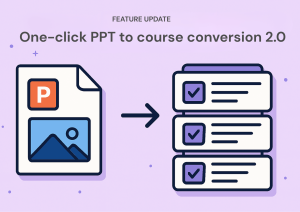
Develop eLearning Courses Successfully: A Step-by-Step Guide
- Author: Urban Rotar
- Published:

How do I start developing an eLearning course?
Begin by defining clear learning objectives that align with your goals. Conduct a needs analysis to understand your audience, select a suitable LMS, and create engaging, multimedia content. Test and publish your course, then promote it effectively.
What is the importance of a Learning Management System (LMS)?
An LMS helps manage and deliver your eLearning content, track learner progress, and provide valuable analytics. Choose an LMS that supports your content and is user-friendly for both administrators and learners.
How can I make my eLearning course engaging?
Use a variety of content types like videos, images, and interactive quizzes. Incorporate real-world scenarios and examples, and ensure accessibility to cater to diverse learners. Regular updates based on feedback also keep content fresh and relevant.
Key Takeaways - Develop eLearning Courses:
- Define clear objectives: Align course objectives with organizational goals using SMART criteria.
- Understand your audience: Conduct thorough needs analysis to tailor content to learner needs.
- Select the right LMS: Choose a user-friendly LMS with features that support your content.
- Create engaging content: Use multimedia elements and interactive activities to maintain learner interest.
- Continuously improve: Collect feedback and monitor progress to make iterative improvements.
- Tailor training programs: Design training programs that align with the specific knowledge and needs of your audience to foster better learning outcomes and overall effectiveness.
Planning and Preparation
Define Your eLearning Course Objectives
The foundation of any eLearning course lies in its objectives. Start by identifying what you want your learners to achieve. Course assignments can be used to measure the achievement of these learning objectives. These objectives should align with your organization’s goals and reflect the skills and knowledge learners will acquire. The more specific your objectives, the better they will guide your course design.
Using the SMART criteria can help create specific, measurable, achievable, relevant, and time-bound objectives. For instance, if you’re developing a course on digital marketing, a SMART objective might be: “By the end of this course, learners will be able to develop a social media strategy that increases engagement by 20% within three months.” Such clear goals guide the course design and ensure it meets its intended purpose. Additionally, having well-defined objectives helps in assessing the effectiveness of your eLearning course. By aligning your objectives with organizational goals, you create a coherent structure that benefits both learners and the organization. The learning objectives should be crafted in a way that they resonate with the learners’ professional and personal development goals.

Conduct a Needs Analysis
Understanding your audience is critical. Conducting a thorough needs analysis helps identify who your learners are and what they need from the course. Analyze the current skills and knowledge gaps and determine the best approach to address these through eLearning. Use data and feedback to inform this process, ensuring that your course content is relevant and targeted. For instance, surveying potential learners about their current challenges can provide insights that shape your course material.
Conducting a needs analysis involves gathering data through various means such as surveys, interviews, and focus groups. This data helps in understanding the demographic details, prior knowledge, and specific learning needs of your audience. It’s essential to identify the gap between the current skills and the desired skills. Once you have this information, you can tailor the course content to bridge these gaps effectively. Additionally, understanding the preferences and learning styles of your audience can help in designing a course that is engaging and effective. This approach not only enhances the learning experience but also increases the likelihood of achieving the desired learning outcomes.

Choose Your Learning Management System (LMS)
Selecting the right Learning Management System (LMS) is a pivotal step. The LMS should be user-friendly and meet your organization’s needs. Consider the features and functionality of various LMS options, ensuring they align with your course content. For example, if your course includes interactive quizzes and multimedia content, your LMS should support these features. Additionally, evaluate the cost and scalability of the LMS to ensure it can grow with your needs.
When choosing an LMS, it’s important to consider factors such as ease of use, compatibility with existing systems, and support services. A good LMS should offer robust tracking and reporting features that allow you to monitor learner progress and engagement. Additionally, it should support various content formats and provide tools for creating engaging content. Some popular LMS options include Moodle, Blackboard, and Coursly AI. Each of these platforms offers unique features and functionalities. For instance, Coursly AI is known for its intuitive interface and powerful analytics tools, making it a preferred choice for many organizations. By choosing the right LMS, you can enhance the delivery and management of your eLearning courses, providing a seamless learning experience for your learners.

Designing Your eLearning Course
Create a Course Outline and Storyboard
A well-structured course outline serves as a roadmap for your eLearning course. Develop a clear and concise outline that guides the design process and helps maintain a logical flow. Complement this with a storyboard to visualize the course content and structure. This step ensures a cohesive and engaging learning experience. Review and revise your outline and storyboard to fine-tune the course structure, making sure it aligns with your learning objectives.
Creating a course outline involves breaking down the course content into manageable sections and organizing them in a logical sequence. This helps in maintaining a clear flow of information and ensures that learners can easily follow along. A storyboard, on the other hand, provides a visual representation of the course, detailing each screen and interaction. This helps in planning the multimedia elements, such as videos, animations, and interactive quizzes. By visualizing the course content, you can identify potential gaps and make necessary adjustments before the development stage. This saves time and resources in the long run and helps in creating a well-rounded and engaging eLearning course.
Develop Engaging Content for Online Courses
Content is king in eLearning, but it’s also essential to present it in a way that captivates and motivates learners. This means going beyond basic text and images to incorporate various multimedia elements such as videos, audio files, and interactive simulations. For example, short instructional videos can break up the monotony of text and provide visual explanations of complex concepts. Similarly, audio files can offer an alternative mode of content delivery for auditory learners.
Interactive quizzes and games are particularly effective in maintaining learner engagement. These elements not only make the learning process more enjoyable but also help reinforce the material by requiring active participation. For instance, branching scenarios can provide learners with real-life decision-making practice, enhancing their critical thinking and problem-solving skills. Additionally, incorporating gamification elements, such as points, badges, and leaderboards, can motivate learners to complete tasks and achieve goals.
It’s also crucial to ensure that the content is accessible to all learners, including those with disabilities. This involves following web accessibility standards, such as providing alternative text for images, captions for videos, and ensuring that the content is navigable using keyboard shortcuts. By creating inclusive content, you can reach a broader audience and provide a positive learning experience for everyone.

Key Features to Building and Implementing Your eLearning Course
Create and Publish Your eLearning Course
With your content ready, using a course authoring tool can simplify the development process. Tools like Articulate Storyline, Adobe Captivate, and Coursly AI offer features that cater to different levels of complexity and interactivity. Articulate Storyline, for example, is known for its user-friendly interface and robust functionality, allowing you to create interactive and engaging courses without extensive technical knowledge. Adobe Captivate, on the other hand, offers advanced features like responsive design and virtual reality integration, making it suitable for more complex projects.
Coursly AI is another powerful tool that combines ease of use with advanced analytics. It provides templates and assets that can be customized to create visually appealing and interactive courses. Moreover, its analytics features allow you to track learner progress and engagement in real-time, providing valuable insights for continuous improvement.
Testing your course before publishing is crucial. This involves checking for technical issues, such as broken links, missing multimedia elements, and compatibility with different devices and browsers. Additionally, pilot testing the course with a small group of learners can provide feedback on the content and user experience, allowing you to make necessary adjustments before the full launch.
Once the course is ready, publishing it involves setting up user access, which might include creating user accounts, enrolling learners, and distributing login information. It’s also important to provide clear instructions on how to navigate the course and access support resources. This can help learners start the course smoothly and reduce any initial confusion or frustration.
Promote and Deliver Your eLearning Course
Effective promotion involves not only marketing the course but also communicating its value to potential learners. This means highlighting the benefits of the course, such as the skills and knowledge they will gain, the flexibility of online learning, and how it can help them achieve their personal and professional goals. Using testimonials and case studies can also be effective in demonstrating the course’s impact and encouraging enrollment.
Leveraging various marketing channels, such as email campaigns, social media, and partnerships with industry organizations, can help reach a broader audience. For example, creating engaging social media posts with visuals and videos can attract attention and generate interest. Collaborating with influencers or thought leaders in your field can also help promote the course to a wider audience.
Providing support and resources is essential for successful course delivery. This includes offering technical support, such as a help desk or live chat, to assist learners with any issues they might encounter. Additionally, providing resources like FAQs, user guides, and discussion forums can help learners navigate the course and engage with the content more effectively. By offering comprehensive support, you can enhance the learner experience and increase course completion rates.

Evaluating and Improving Your eLearning Course
Track Learner Progress and Engagement
Using your LMS to track learner progress and engagement provides valuable data that can inform future course development. This involves monitoring metrics such as course completion rates, assessment scores, and time spent on each module. For example, if a significant number of learners are spending a disproportionate amount of time on a particular module, it might indicate that the content is too complex or not engaging enough.
Analyzing this data helps identify trends and patterns that can inform improvements. For instance, if learners are consistently performing poorly on certain assessments, it might suggest a need for additional instructional support or review materials. Conversely, high engagement and completion rates can indicate that the content and delivery methods are effective, providing a model for future courses.
Regularly reviewing and updating the course content based on learner feedback and performance data is essential for maintaining its relevance and effectiveness. This might involve revising outdated content, incorporating new information, or enhancing the interactivity of the course. By continuously monitoring and improving your eLearning courses, you can ensure they remain engaging and effective for learners.

Collect Learner Feedback and Improve
Learner feedback is a goldmine of information for course improvement. Collecting this feedback through surveys, questionnaires, and evaluations helps you understand learners’ experiences and identify areas for enhancement. Questions should cover various aspects of the course, including content quality, delivery methods, ease of navigation, and overall satisfaction.
Analyzing feedback allows you to identify common themes and issues. For example, if multiple learners report difficulty with a particular module or activity, it might indicate a need for simplification or additional support. Similarly, positive feedback on certain elements, such as interactive quizzes or real-world examples, can highlight what’s working well and should be emphasized in future courses.
Implementing changes based on feedback demonstrates to learners that their opinions are valued and taken seriously. This can increase their satisfaction and engagement with the course. Additionally, keeping an open channel for ongoing feedback allows you to continuously gather insights and make iterative improvements. By creating a culture of continuous improve

Best Practices for eLearning Course Development
Use Instructional Design Principles
Applying instructional design principles helps in creating structured and engaging eLearning courses. These principles involve a systematic approach to course development, ensuring that the content is logically organized and aligned with the learning objectives. One widely used instructional design model is ADDIE, which stands for Analysis, Design, Development, Implementation, and Evaluation. This model provides a framework for designing effective eLearning courses.
During the analysis phase, you identify the learning needs and objectives, as well as the characteristics of the target audience. This information guides the design phase, where you develop the course structure, content, and instructional strategies. The development phase involves creating the actual course materials, such as videos, quizzes, and interactive activities. During the implementation phase, the course is delivered to learners, and the final phase, evaluation, involves assessing the effectiveness of the course and making necessary improvements.
By following instructional design principles, you can create eLearning courses that are well-organized, engaging, and aligned with the desired learning outcomes. This approach helps in maintaining a clear focus on the learning objectives and ensures that the content is presented in a way that is easy to understand and engaging for learners.
Developing eLearning courses involves careful planning, thoughtful design, and ongoing evaluation. By following these steps and incorporating best practices, you can create eLearning courses that are not only educational but also engaging and impactful. This comprehensive approach ensures that your courses meet the needs of learners and achieve the desired learning outcomes, providing a valuable and rewarding learning experience.



